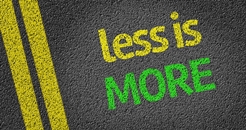 Do less and feel good about it
Do less and feel good about it
From an article by The Next Big Idea Club
Leidy Klotz is a professor at the University of Virginia, where he is appointed in the schools of engineering and architecture. Two years ago, he authored Subtract: The Untapped Science of Less.
During the pandemic we experienced a period of less and as we come out of that period, there could be a tendency to add, to get busy, to fill our time. Revisiting Leidy's research might help here.
In his book, Leidy shares 5 key insights. Here's a summary:
1. We systematically overlook subtraction.
My research has shown that people systematically overlook subtraction. It happens in lots of areas, e.g. travel itineraries, recipes, and writing. When we’re trying to take things from how they are to how we want them to be, our first instinct is to think “What can I add?,” which means we’re overlooking one of the most basic ways to make change.
2. Our failure to subtract is a root cause; our cluttered calendars, closets, and inboxes are just symptoms.
A lot of contemporary authors urge us to subtract. Marie Kondo’s recommendation to get rid of everything that doesn’t spark joy has improved my life. Cal Newport has terrific advice about digital minimalism and getting rid of email. And Tim Ferriss’ 'The 4-Hour Workweek' reminds us that one of the ways we can be more productive and get more joy out of our work is to do less of it.
This kind of advice has been around for a long time, from thinkers like Lao Tzu (“To attain knowledge, add things every day. To attain wisdom, remove things every day.”) and Leonardo da Vinci (“A poet knows he has achieved perfection not when there is nothing left to add, but when there is nothing left to take away.”) But why do we need such advice? It’s because when left to our own devices, we tend to overlook subtraction as a way to solve problems.
3. We need to respect the forces that are pushing us toward more.
One of the reasons we tend to overlook subtraction as a solution for problems is that there are biological, cultural, and economic forces encouraging us to do more, not less. Just as male bowerbirds try to impress potential mates by building elaborate nests, humans have a tendency to display competence by making things.
When you build something, it sits there as firsthand evidence of your brilliance—whereas subtraction is rarely recognized, even when it’s a better solution to a problem.
4. We need to stop thinking “add or subtract” and start thinking, “add and subtract.”
One of the ways we reason is by positioning ideas relative to each other, such that if one idea is true, then some other idea cannot be true: If we add, then we cannot subtract; if we subtract, then we cannot add. When trying to solve a problem, our first instinct is usually to add, and since we imagine adding and subtracting are in opposition, we fail to consider subtraction. But if we can shift our thinking slightly from “add or subtract” to “add and subtract” new possibilities will occur to us.
5. Bigger is not necessarily better.
Just as we default to adding to our closets and calendars rather than subtracting, we also have a tendency to add to our mental models. And just as it’s harder to subtract in the physical world, it’s harder to subtract from our mental models, but it’s powerful when we do.
If you look at Nobel Prize winners and people who have made transformative scientific advances over the years, what they’ve often done is not necessarily added to our collective knowledge, but rather edited it. To achieve wisdom for society and for us as individuals, we’ve got to get past this notion that bigger is better. Often, the more powerful approach to making change is by subtracting.
Read the full article here.
What can you subtract?
Retweet about this article:
From an article by The Next Big Idea Club, 09/05/2023